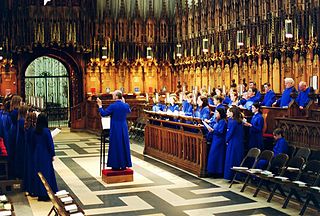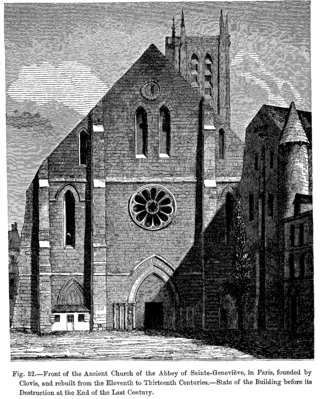Related Research Articles

Renaissance music is traditionally understood to cover European music of the 15th and 16th centuries, later than the Renaissance era as it is understood in other disciplines. Rather than starting from the early 14th-century ars nova, the Trecento music was treated by musicology as a coda to medieval music and the new era dated from the rise of triadic harmony and the spread of the contenance angloise style from the British Isles to the Burgundian School. A convenient watershed for its end is the adoption of basso continuo at the beginning of the Baroque period.

A choir, also known as a chorale or chorus is a musical ensemble of singers. Choral music, in turn, is the music written specifically for such an ensemble to perform or in other words is the music performed by the ensemble. Choirs may perform music from the classical music repertoire, which spans from the medieval era to the present, or popular music repertoire. Most choirs are led by a conductor, who leads the performances with arm, hand, and facial gestures.

An antiphon is a short chant in Christian ritual, sung as a refrain. The texts of antiphons are usually taken from the Psalms or Scripture, but may also be freely composed. Their form was favored by St Ambrose and they feature prominently in Ambrosian chant, but they are used widely in Gregorian chant as well. They may be used during Mass, for the Introit, the Offertory or the Communion. They may also be used in the Liturgy of the Hours, typically for Lauds or Vespers.

The Mass is a form of sacred musical composition that sets the invariable portions of the Christian Eucharistic liturgy, known as the Mass.

Vespro della Beata Vergine, SV 206, is a musical setting by Claudio Monteverdi of the evening vespers on Marian feasts, scored for soloists, choirs, and orchestra. It is an ambitious work in scope and in its variety of style and scoring, and has a duration of around 90 minutes. Published in Venice as Sanctissimae Virgini Missa senis vocibus ac Vesperae pluribus decantandae, cum nonnullis sacris concentibus, ad Sacella sive Principum Cubicula accommodata, it is sometimes called Monteverdi's Vespers of 1610.

Jean (Jehan) Titelouze was a French Catholic priest, composer, poet and organist of the late Renaissance and early Baroque periods. He was a canon and organist at Rouen Cathedral. His style was firmly rooted in the Renaissance vocal tradition and as such, was far removed from the distinctly French style of organ music that developed during the mid-17th century. However, his hymns and Magnificat settings are the earliest known published French organ collections, and he is regarded as the first composer of the French organ school.

Belarus is an Eastern European country with a rich tradition of folk and religious music. The country's folk music traditions can be traced back to the times of the Grand Duchy of Lithuania. The country's musical traditions spread with its people to countries like Russia, Canada, United States, Kazakhstan and Latvia. The people of Belarus were exposed mostly to Russian pop music during this period and also after independence in 1991. In 2002, however, President Alexander Lukashenko has signed a decree requiring 50% of all FM broadcast music to be Belarusian in origin, and since 1 January 2005 the rule has been even stricter. However, it does not regulate the language of the songs, so most of the music which is broadcast is still in Russian.

Anglican church music is music that is written for Christian worship in Anglican religious services, forming part of the liturgy. It mostly consists of pieces written to be sung by a church choir, which may sing a cappella or accompanied by an organ.

Johann Caspar Kerll was a German Baroque composer and organist. He is also known as Kerl, Gherl, Giovanni Gasparo Cherll and Gaspard Kerle.

The French Organ Mass is a type of Low Mass that came into use during the Baroque era. Essentially it is a Low Mass with organ music playing throughout: part of the so-called alternatim practice.

Missa brevis usually refers to a Mass composition that is short because part of the text of the Mass ordinary that is usually set to music in a full Mass is left out, or because its execution time is relatively short.

André Raison was a French Baroque composer and organist. During his lifetime he was one of the most famous French organists and an important influence on French organ music. He published two collections of organ works, in 1688 and 1714. The first contains liturgical music intended for monasteries and a preface with information on contemporary performance practice. The second contains mostly noëls.
Tra le sollecitudini was a motu proprio issued 22 November 1903 by Pope Pius X that detailed regulations for the performance of music in the Catholic Church. The title is taken from the opening phrase of the document. It begins: "Among the concernsof the pastoral office, ... a leading one is without question that of maintaining and promoting the decorum of the House of God in which the august mysteries of religion are celebrated...." The regulations pointed toward more traditional music and critiqued the turn toward modern, orchestral productions at Mass.

Early music of Britain and Ireland, from the earliest recorded times until the beginnings of the Baroque in the 17th century, was a diverse and rich culture, including sacred and secular music and ranging from the popular to the elite. Each of the major nations of England, Ireland, Scotland, and Wales retained unique forms of music and of instrumentation, but British music was highly influenced by continental developments, while British composers made an important contribution to many of the major movements in early music in Europe, including the polyphony of the Ars Nova and laid some of the foundations of later national and international classical music. Musicians from the British Isles also developed some distinctive forms of music, including Celtic chant, the Contenance Angloise, the rota, polyphonic votive antiphons, and the carol in the medieval era and English madrigals, lute ayres, and masques in the Renaissance era, which would lead to the development of English language opera at the height of the Baroque in the 18th century.
The Magnificat Baroque Ensemble, or Magnificat, is an early music ensemble of voices and instruments specializing in the Baroque music of the 17th century under the artistic direction of Baroque cellist Warren Stewart. Stewart founded the ensemble in San Francisco in 1989 with Baroque harpsichordist Susan Harvey. Harvey resigned in 2000, and the group has remained under the sole musical direction of Stewart since then. The group derives its name from the first word of the Latin translation of the Canticle of Mary in the Gospel of Luke, Magnificat anima mea, "My soul magnifies the Lord", which is sung during the Roman Catholic evening prayer or vespers service.

Church music in Scotland includes all musical composition and performance of music in the context of Christian worship in Scotland, from the beginnings of Christianisation in the fifth century, to the present day. The sources for Scottish Medieval music are extremely limited due to factors including a turbulent political history, the destructive practices of the Scottish Reformation, the climate and the relatively late arrival of music printing. In the early Middle Ages, ecclesiastical music was dominated by monophonic plainchant, which led to the development of a distinct form of liturgical Celtic chant. It was superseded from the eleventh century by more complex Gregorian chant. In the High Middle Ages, the need for large numbers of singing priests to fulfill the obligations of church services led to the foundation of a system of song schools, to train boys as choristers and priests. From the thirteenth century, Scottish church music was increasingly influenced by continental developments. Monophony was replaced from the fourteenth century by the Ars Nova consisting of complex polyphony. Survivals of works from the first half of the sixteenth century indicate the quality and scope of music that was undertaken at the end of the Medieval period. The outstanding Scottish composer of the first half of the sixteenth century was Robert Carver, who produced complex polyphonic music.

The Messe des pauvres is a partial musical setting of the mass for mixed choir and organ by Erik Satie. Composed between 1893 and 1895, it is Satie's only liturgical work and the culmination of his "Rosicrucian" or "mystic" period. It was published posthumously in 1929. A performance lasts around 18 minutes.
References
- ↑ "Benjamin van Wye, Review of Marc-Antoine Charpentier, Messe pour le Port-Royal, in Journal of Seventeenth-Century Music 1999". Archived from the original on 2011-07-19. Retrieved 2010-10-26.. See also Arnaldo Morelli, "The role of the organ in the performance practices of Italian sacred polyphony during the Cinquecento", Musica Disciplina , 50 (1996), pp. 239-270.
- ↑ Tra le Sollecitudini – Instruction on Sacred Music